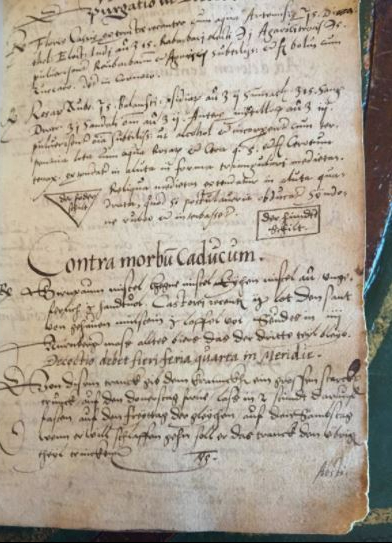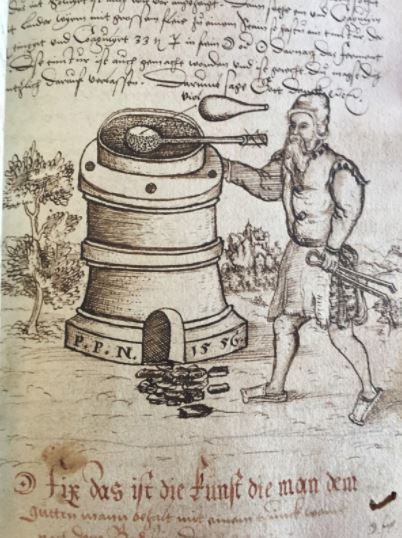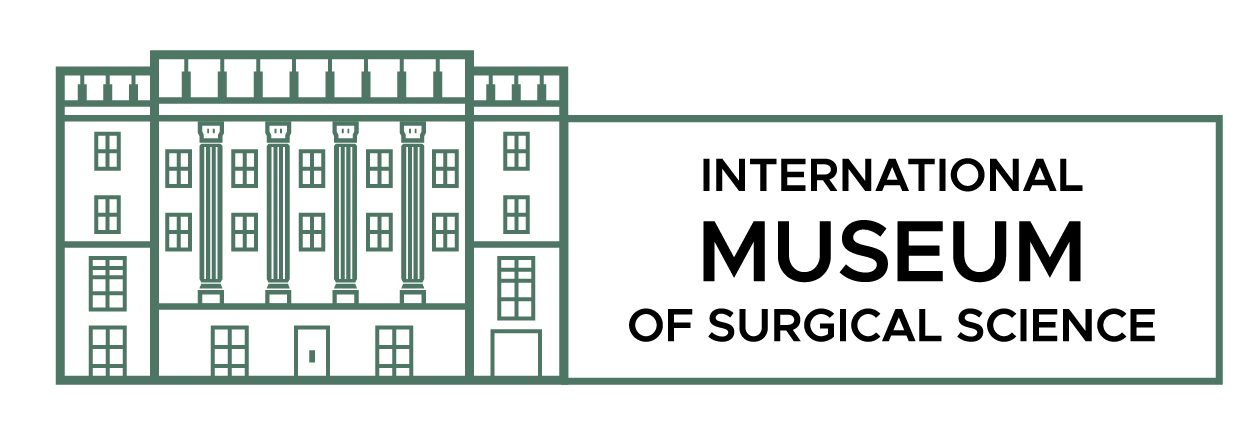Published by Sally Monroe.

Dr. Paulus Pfann’s Receptbuch in the Thorek Manuscripts and Rare Books Collection at the International Museum of Surgical Science
One of the most exciting things about the Thorek Manuscripts and Rare Books Collection is that it contains no shortage of strange and enigmatic books. One of these unusual texts is, according to the inscription on its spine, Pfann’s Receptbuch.[1] Written in both Latin and German in a beautiful, ornate script and dated 1550, the Receptbuch appears to be one Dr. Paulus Pfann’s personal record of his patients. It includes their particular ailments and the concoctions he prescribed, as well as his alchemical home remedies.

Inside cover of Receptbuch, including the typed description of the text and Dr. Max Thorek’s personal library card
Because Pfann’s handwriting is so ornamental and replete with symbology, it can be difficult to read. Luckily, pasted inside the front cover of the Receptbuch is a typed summary of its contents, and because of its placement behind the official Thorek library card, it appears to predate accession into the collection. Somewhat unfortunately, however, this anonymous guide is written in outmoded German with many curious abbreviations – something that both Google Translate and German-speaking friends have struggled to decipher.
Regardless, we know that the writer describes Pfann’s book as a “Recipe book, medical-chemical, of a Carinthian doctor around 1550.” Here, “Carinthian” refers to a region in southern Austria. Several lines later, however, the text mentions the Latin word “Norimbergensis,” which refers to the city of Nuremberg. The text, Historiches Lexicon evangelischer Jubel-Priester, Vol. III by Johann Matthias Gross, written in 1746, mentions a Paulus Pfann as Nuremburg’s Rector and city physician beginning in 1545.[2] Further, Hannah Saunders Murphy’s “Reforming Medicine in Sixteenth Century Nuremburg” places a doctor named Paulus Pfann in the city sometime during the mid-1500s.[3] Surely, this cannot be purely coincidental, meaning that in all likelihood Pfann was not an Austrian after all.

Symbol Explanations in Receptbuch
Biographical details aside, the typed text contains little insight into the more obscure aspects of the Receptbuch. For example, one of the first pages of Pfann’s text offers a guide to translating its symbols. They appear to correspond to different elements: the sun refers to gold, the moon to silver, and Venus to bronze. How exactly these symbols function within the text is less clear. In one instance, “coagulum” – that is, rennet – appears next to the marking for bronze. It may be that the Receptbuch was intended for Pfann’s personal reference rather than as a guide to other aspiring physicians and that his coding system was thus intelligible only to him.

Epilepsy Recipe in Receptbuch
Other aspects of the Receptbuch are less inscrutable but similarly bizarre. His notes on curing epilepsy – “Contra morbu Caducum” – require the physician to cook the prescribed concoction exactly at noon on a Wednesday. This wisdom is unexplained, but because the recipe is so concise, we can assume that Pfann considered it an important step in his medical formula. Equally strange is an image on page 139. It depicts a man, possibly Pfann himself, handling a large pair of tongs. He is standing next to what appears to be an oven, perhaps cooking one of his alchemical formulas. In the background is a scene typical of the time, complete with a castle atop a mountain.
Much of this Receptbuch remains a mystery, which is what makes it so interesting to examine. One can only imagine what Pfann’s medical practice must have been like and what strange symbologies and recipes must have been swirling in his head. There are innumerable books tucked away in the Thorek Manuscripts and Rare Books Collection that provide glimpses into the work of physicians hundreds of years ago. Stay tuned for more interesting finds as my research continues!

Illustration in Receptbuch
Sources:
[1] Pfann, Paulus. Receptbuch, 1550.
[2] Gross, Johann Matthias. Historisches Lexicon evangelischer Jubel-Priester, Volume 3. Bei W.M. Endterischen Töchtern und J.A. Engelbrecht, 1746. https://books.google.com/books?id=6yUNAAAAIAAJ&pg=RA1-PA57&lpg=RA1-PA57&dq=paulus+pfann&source=bl&ots=pggbebbaUc&sig=LdpYcOJxH91onHfThx2_BO7jXTc&hl=en&sa=X&ved=0ahUKEwjFiuGEhOjZAhWJ7YMKHfK6BO4Q6AEILDAA#v=onepage&q=paulus%20pfann&f=false
[3] Murphy, Hannah Saunders. Reforming Medicine in Sixteenth Century. 2012. University of California, Berkeley, PhD Dissertation. http://digitalassets.lib.berkeley.edu/etd/ucb/text/Murphy_berkeley_0028E_12995.pdf
Sally Monroe is the current Collections Intern (Library) at IMSS and a graduate student in the Museum and Exhibition Studies program at University of Illinois at Chicago. She is interested in the intersection of cultural spaces and representations of pain.

